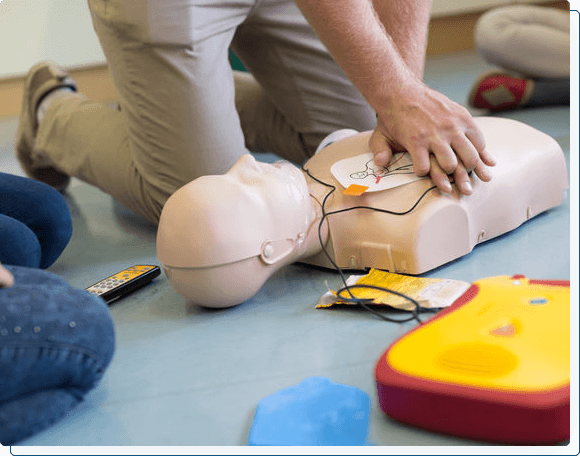The skills learned in the CPR certification course can save a person’s life during a cardiac arrest or brain failure. Everyone should be well aware of this life-saving skill because the majority of cardiac arrest cases take place outside of hospitals. When a person’s heart stops beating, cardiopulmonary resuscitation (CPR) is an urgent procedure used to save lives.
If a victim does not receive the necessary assistance during such an incident, they may die or suffer irreversible brain damage. The chance of survival can be increased after cardiac arrest by performing CPR right away. Slightly more than 5% of the approximately 350,000 non-hospital resuscitation attempts performed in the US each year are effective.
What is Cardiopulmonary Resuscitation?
CPR is an emergency intervention for individuals who are suffering from severe dyspnea or cardiac arrest. Until trained medical assistance arrives, chest compressions and artificial ventilation—typically mouth-to-mouth breathing—are used to maintain blood flow and oxygen delivery to critical organs.
The heart stops pumping blood efficiently during cardiac arrest, causing the body’s oxygen levels to drop quickly. The goal of CPR is to manually pump oxygen-rich blood to the patient until professional medical assistance, such as defibrillation, can be provided.
CPR Technique: What Is It?
The standard CPR method requires a precise ratio of breaths to chest compressions. The techniques are different for adults and children. These are shown below:
Compressions for adult patients:
- Administer at a rate of 100 to 120 compressions per minute.
- Each compression should be at least 5-6 cm deep.
- Ensures proper blood flow and oxygenation of essential organs.
Compressions for children:
- Depth should be about 4 cm in children.
Compressions for infants:
- Depth should be less than 4 cm in infants.
Those seeking CPR certification are taught how to recognize the warning signs of cardiac arrest and breathing problems. Certification verifies that you have received sufficient training and are competent to perform CPR.
Importance of CPR Certification Training
CPR training enables people to assist those who are hurt or experiencing a medical emergency. CPR can stop more damage, lessen the severity of injuries, and save lives. In a medical emergency, knowing how to appropriately assess the situation, administer the necessary care, and request additional assistance can be critical. Here are some of the advantages of the CPR certification course for everyone:
- Life-saving CPR
It is not necessary to be an emergency responder, medical professional, or armed forces member to save lives during cardiac crises. If more people were aware of CPR, more cardiac arrest victims would survive. The probability of survival for individuals undergoing cardiac arrest is contingent upon the prompt delivery of emergency medical assistance and the presence of a CPR provider.
- CPR Training: Accessible to Everyone.
The CPR certification program has no age or educational restrictions. Anyone can enroll in the course regardless of their background. During CPR training, both theoretical knowledge and real-world experience are imparted.
After completing the course, securing passing marks in the exam is essential. Successful candidates receive a two-year certificate. Effective CPR can be taught to kids as young as nine years old. Furthermore, good samaritan laws exist to protect persons from any legal dispute.
- CPR Prevents Brain Cell Failure
Heart attack victims risk developing irreversible brain damage, which would render them bedridden or incapable of performing regular daily activities. Chest compressions administered to cardiac arrest victims help maintain the brain’s oxygen supply, preventing massive cell death.
- Proper CPR Treatment During Cardiac Arrest
Early detection of cardiac arrest can save lives. Those with CPR certification learn how to assess signs of cardiac arrest and determine when CPR is required.
- Quicken the Healing Process
Patients have a doubled chance of survival if they receive cardiopulmonary resuscitation (CPR) in the first two minutes after going into cardiac arrest. The patient will arrive at the hospital on schedule, as planned. Therefore, the body will suffer less and recover faster if CPR is started as soon as possible after cardiac arrest. Moreover, there is a lower risk of another cardiac arrest because the brain and heart suffer less.
Final Thought
CPR certification aims to provide vital skills that can save lives, even if you are not a medical professional. When someone experiences sudden cardiac arrest, the actions of those around them can have a significant impact. This includes contacting emergency services, administering CPR, or providing any other necessary first aid. Staying current on the latest CPR guidelines is essential as they evolve in response to scientific and technological developments. Various reputable institutes offer comprehensive CPR certification courses with easily understandable study materials. Start your research for a good institution and utilize their online courses to advance your career.
Keep an eye for more news & updates on Chicago Heading!

